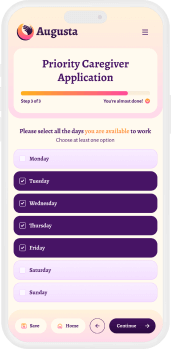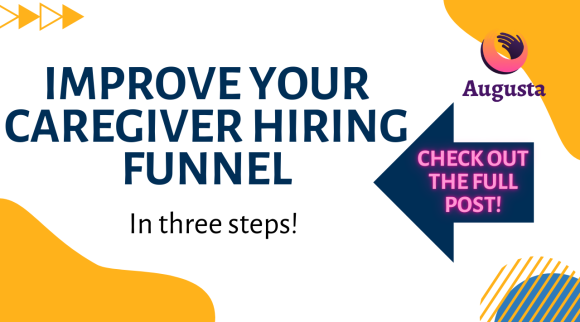Introduction
Home Care agency owners and operators today report turning away up to 50% of their clients because they don’t have enough caregivers to staff their current cases, let alone grow their business the way they would like to. It’s become common knowledge that there is a shortage of caregivers. But, when you speak with people who know the industry well, you realize how much more complicated it really is.
The caregiver shortage is more than just simply not having enough applicants. Home care owners and operators report that the real issue is having the right caregivers at the right time for their current cases. But how are some home care operators succeeding through this challenge? In sales, there is a tried and true principal: always be prospecting. To grow a consistent business you must be filling the funnel of clients from the top every single day. In home care, caregivers are the lifeblood of the business. And as such, need to be treated the same way you would with prospecting for clients.
Successful home care agency operators are always hiring and they’re always hiring efficiently. Continually keeping a deep ‘bench’ of caregivers is integral to being able to capture clients who often need a caregiver within only days of their initial inquiry. In sum, one of the keys to success is to consider how efficient your hiring funnel is.
In this article, we share the 3 steps for improving the efficiency of your caregiver hiring funnel.
-
Review your current hiring funnel and full recruiting process from a high level.
-
Consider the candidate experience.
-
Analyze your data on a consistent basis and make a weekly and monthly action plan to improve.
-
Review your current hiring funnel and full recruiting process from a high level.
-
What are your goals? Why have a goal number of hires?
-
We often hear from home care agencies that they don’t know how many people they will need on a week to week basis. To manage the uncertainty, you or your hiring manager needs to be always recruiting. Yes, some caregivers you hire may end up at other agencies, but the alternative is passing on business that a larger agency is able to handle.
-
Setting a goal number of hires per week means that you always have a strong bench of caregivers to pull from. And, it means that you have a very clear way to judge the performance of your recruiter and your applicant sources.
-
-
Are you able to track your applicants?
-
To measure the clear goals that you set, you need to be able to track your hiring process. There are a number of top Applicant Tracking Systems (ATS) out there that can help provide you the reports you need to gain clarity and consistency. Our customers use ApplicantStack and CareerPlug among others. Check out other great ATSs here.
-
-
What metrics are you tracking and why?
-
The first, and most important, number to track is the number of hires per week. This is simply the number people that were hired within each week. Following that number, there are a few other important metrics to track:
-
Applicant time to close.
-
The applicant time to close is how many days (or hours) it takes from the time a new application comes in to the time that they’re either rejected or hired.
-
There is much data now that shows an effective hiring funnel happens fast. Faster response times are also rewarded by all social media channels and will improve your future results from job ads on Facebook and similar sites. If you don’t know how long it takes to process applications to closed won or lost, how would you improve the speed?
-
-
Applicant to qualified ratio.
-
The applicant to qualified ratio is the number of applicants that were qualified enough for an interview divided by the total number of applicants in a specific time period.
-
From one of our customer examples over 6 weeks: 22 qualified applicants out of 44 total applicants = 50% applicant to qualified rate.
-
-
-
-
-
-
-
-
Qualified applicant to close ratio.
-
The application to qualified and qualified to hire ratios help you understand two important factors:
-
If your ratios are consistent, then you know exactly how many applicants you need at the top of the funnel to meet your hiring goal.
-
It gives you an exact number of interviews that your hiring manager or recruiter needs to hit each week.
-
For example, let’s say your hiring goal is 10 new caregivers per week.
-
You know 50% of applicants are qualified enough for an interview with your current sources. And you know you’ll be able to hire 64% of the qualified applicants. The math looks like this:
-
32 applicants *50% qualified = 16
-
16 qualified *64% hired = 10.24
-
-
This means that your hiring manager should have a goal of at least 16 interviews with qualified caregivers per week to produce 10 hires.
-
And, your applicant sources need to be producing at least 32 total leads per month to get those 16 interviews.
-
-
-
-
-
-
A word to the wise: your hiring funnel metrics will change over time. Best practice for managing a funnel dictates that you should measure it weekly, monthly and quarterly, ensuring that you’re keeping up to date with how your ratios change. If your ratios change (in a positive or negative way), then you’ll need to change your hiring manager’s goal to reflect that.
-
-
-
What is your ideal candidate profile? What data is that based on?
-
How would you find your best caregiver if you don’t know how to define who they are? In short, the ideal candidate profile is similar to the buyer personas that marketing and sales teams use to define their ideal customers.
-
A candidate profile, for example, might include characteristics like compassionate, optimistic, confident, reliable, family caregiving or customer service background, and other traits and skills you’d ultimately like to see in the candidate you hire.
-
It also contains the ideal candidate’s preferred online hangouts (Facebook and TikTok primarily for caregivers) as well as communication channels. The profile answers the questions about motivation of your ideal candidate, what their educational background and current job are and even what their career goals are.
-
-
-
-
What are the stages of your hiring funnel? Are they clear and well defined throughout the team that deals with recruitment?
-
Here’s an example of hiring funnel stages:
-
Application
-
Qualified
-
Interview scheduled
-
Interviewed
-
Job Offer Letter
-
Hired (won)
-
Rejected (lost)
-
-
Your recruiter should be managing their candidates as they would a sales pipeline. Every time they communicate with a candidate, they should reflect the stage in your ATS appropriately.
2. Consider the Candidate Experience.
-
-
-
What do you want the caregiver to take-away from the experience, regardless of whether or not they’re hired?
-
Candidate experience is how job seekers perceive and react to a company’s recruitment cycle including attracting, sourcing, recruiting, interviewing, hiring, and onboarding. All of the tips in this article will help support an improved candidate experience. But, according to Ideal, there are four best practices that you should aim for to maintain a positive candidate experience (regardless of whether the applicant is hired):
-
“[Employers with a great candidate experience] listen and communicate more often
-
They set clear expectations about the recruiting process from pre-application to onboarding
-
They hold themselves more accountable for candidate experience and measure it regularly and consistently
-
They are perceived by candidates as having a fairer process (e.g., candidates believe they have been able to share why their knowledge, skills and experience deserves consideration for the jobs to which they have applied)”
-
-
-
How long does it take for a caregiver to go through your hiring process?
-
If you’ve made it this far in this guide, then you already know that speed through the hiring funnel is important. Even with the best candidate marketing your caregivers are still applying to a few jobs at one time. If you can be the first to follow up on their application, your likelihood of success increases.
-
Caregivers want to know that you’re on top of your business. When you reply quickly, it fosters trust in your hiring process and ultimately your business.
-
-
How many steps is your hiring process for the candidate? Can they be combined for efficiency?
-
Wages for caregivers vary throughout the US but average for the country is still around $13-14/hour while average wage for similarly skilled jobs at an Amazon warehouse is $18/hour. Candidates for an amazon warehouse job report a hiring process of one week or less.
-
Due to competing with the Amazon’s with the world, unfortunately it’s not realistic to expect that a prospective $13-$14/hour worker will complete a long or drawn out multi-step hiring process.
-
If you have long-form formal application which you need filled out in its entirety, can you separate it into two parts? Consider this approach:
-
Part 1 could include just the qualification criteria (your lead form) completed online and used as your screening tool
-
Part 2: have the applicant complete employment background for the last 5 years + references on the full length in person at the same time as their interview. If all criteria are met, and the in-person interview goes well, then you could make a provisional job offer on the spot (pending reference checks and other state required background screening, fingerprinting, etc).
-
Part 3: before they leave the office, schedule their onboarding training so that you continue momentum in the process.
-
-
Have your recruiter check-in with the candidates going through this process on a regular basis until they’re working with a client. Anytime they’re waiting for a step in the process, they could be considering other opportunities.
3. Analyze your data on a consistent basis and make a weekly and monthly action plan to improve
-
Consistency is king in your hiring funnel and related processes. When you have a goal, track it and measure your results on a consistent basis, you’ll begin to see where the bottlenecks are and make educated decisions based on the data.
-
For example, if you see that your total applicants are down over the course of a month. Consider your applicant sources, is it time to try a new job board or try a new method for sourcing? Which sources are give you a consistent flow? Which are not?
-
Alternatively, for example, if you’re not able to qualify as many caregivers as you need, how long is it taking to contact them? Is there something getting in the way of your recruiters ability to contact them rapidly? Is your recruiter communicating the value proposition of the role well and accurately?
-
If you come across either of these scenarios, you’ll discover the questions you need to answer to change the outcomes.
-
While there is no silver bullet out there for a perfect hiring funnel that works the same way every single time, there are improvements you can make to get better results.
Key takeaways:
-
Review your hiring funnel at a high level. You need to have a system with goals and metrics to track your progress.
-
Consider the experience of the candidates going through the process. You’ll figure out if you’re attracting the right people, setting the right expectations and communicating effectively.
-
Review your metrics consistently at regular intervals to continually improve your results.


